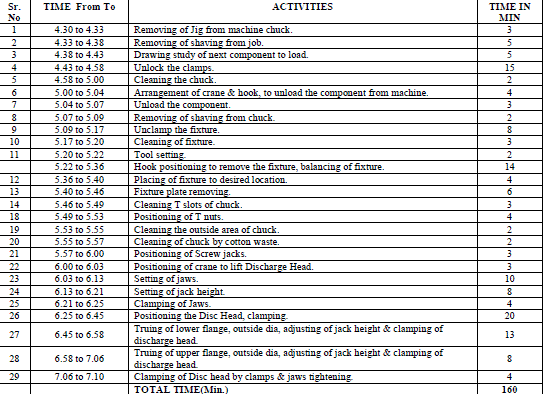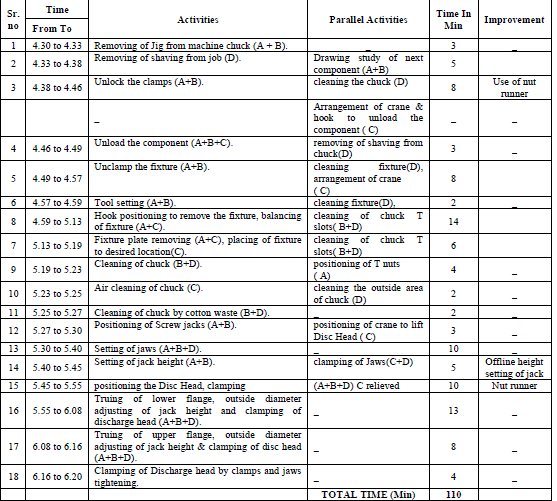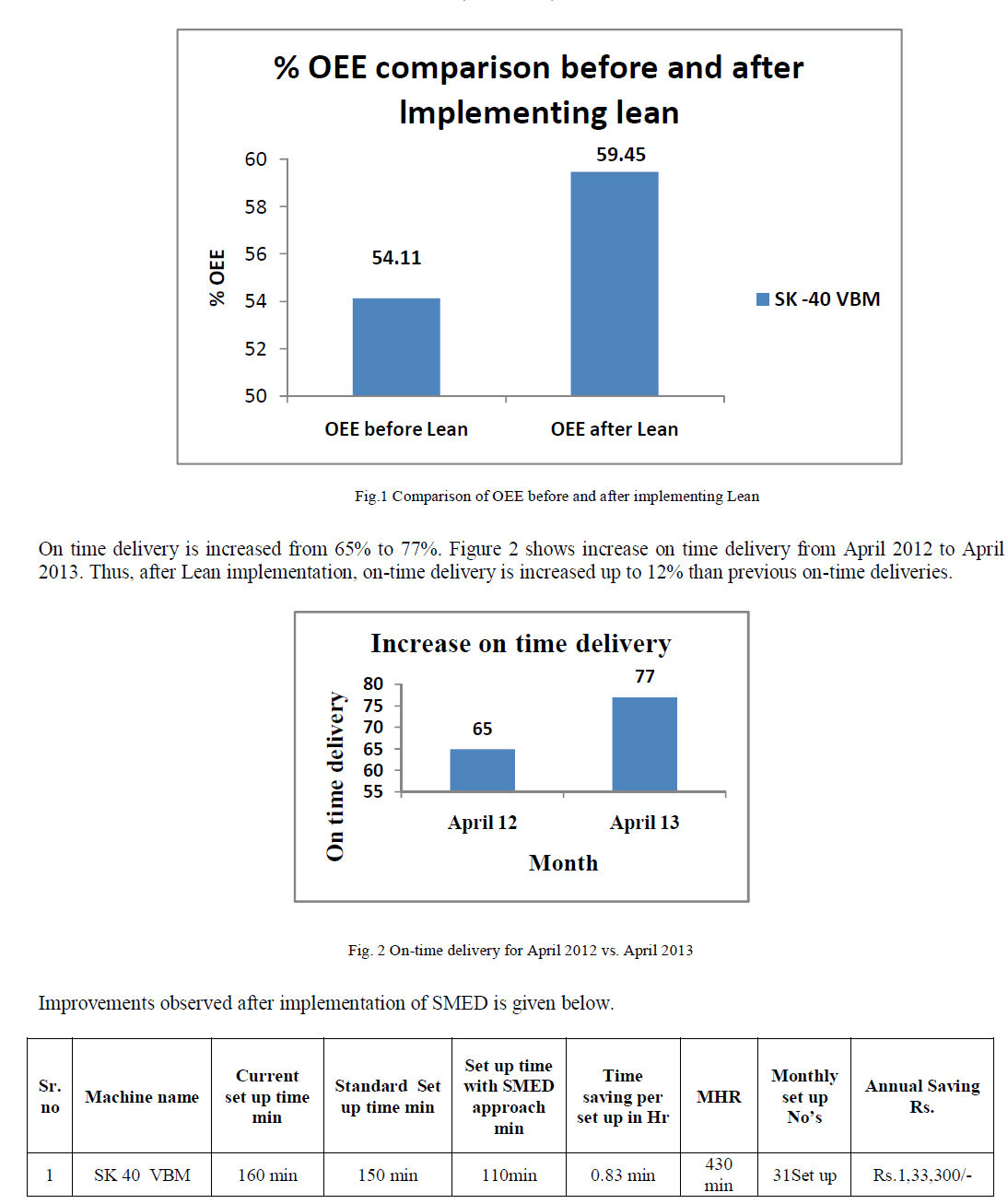ISSN ONLINE(2319-8753)PRINT(2347-6710)
ISSN ONLINE(2319-8753)PRINT(2347-6710)
Mulla M. L.1,Bhatwadekar S.G2, Pandit S.V3
|
| Related article at Pubmed, Scholar Google |
Visit for more related articles at International Journal of Innovative Research in Science, Engineering and Technology
Lean production is an integrated management system that emphasizes to a great extent the elimination of waste and the continuous improvement of operations for the optimization of the benefits derived from its immediate use of scarce resources. It is a complete system that welds the activities of everyone from top management to line workers, to suppliers that can respond almost instantly to marketing demand from consumers. The background of Lean thinking is based in the history of Japanese manufacturing techniques which have now been applied world-wide within many types of industries such as Manufacturing, Construction, Design, Supply Chain, Service industries. This paper revels why changeover time reduction is important in manufacturing industries and the various tool and techniques available within Lean manufacturing mainly SMED for changeover time reduction and its application in Pump Manufacturing industry. This paper also describes principles; benefits and the procedure of application of SMED.
Keywords |
| Lean, Changeover time, Lean Tools and techniques, SMED. |
INTRODUCTION |
| Lean is a culture of real and continuous optimization. Lean as a concept of continuous optimization in the midst of limited resources must be practiced continuously as a long term organizational norm. Imbibing this practice could be carried out even at the expense of short-term financial goals. In making Lean practice a culture in an organization, the five key aspects of satisfying the customer, ensuring real value in the value stream, a well prepared effective and efficient human resource, an in built Just-In-Time system for all activities including deliveries and inventory management and a hallmark of total quality in Process and product must all be built on the foundation of continuous improvement. |
| The birth of lean was in Japan within Toyota in the 1940s.The Toyota Production System was based around the desire to produce in a continuous flow which did not rely on long production runs to be efficient; it was based around the recognition that only a small fraction of the total time and effort to process a product added value to the end customer[2]. |
| Lean concept was clearly the opposite of what the western world was doing, here mass production based around materials resource planning (MRP) and complex computerized systems was developing alongside the mass production philosophies originally developed by Henry Ford, i.e., large high volume production of standardized products with minimal product changeovers [8]. |
| In comparison, the term lean comes from the upside of the production method which enquires half the human effort, half the manufacturing space, half the investment and half the engineering hours to develop a new product in half the time. Lean Thinking helped us to understand the principles of lean: |
| i) The identification of value. |
| ii) The elimination of waste. |
| iii) The generation of flow. |
| Company manufactures a variety of pumps, many customers spread across the country. The order quantity of pump was very small because loss of production time at bottleneck machine. Because of bottlenecks, production target of pumps has not achieved as per targeted demand. Thus, there was need to increase the productivity of targeted pump by improving manufacturing performance of pump production line. This includes increasing capacity of machine resources and better utilization of workforces. The company has offered this problem for productivity improvement of targeted pump product. It is proposed to apply Lean Manufacturing approach to current problem by focusing on bottleneck in the production line and improve the productivity of the pump production line by taking care of capacity constraint resource. |
CASE STUDY |
| The case study carried out at Pumps Manufacturing industry in Maharashtra. The analysis study applied for selected machine in the manufacturing plant, which is semiautomatic Vertical Boring Machine (VBM). The new emerging approach of lean manufacturing through the technique of SMED applied to manufacturing machine to reduce change over time of pump components. This tool is selected by management of company. The Central planning department, production planning and control department and industrial engineering department have helped us to give past record values of selected manufacturing line. The data such as Central planning department as given monthly customer order, production planning department has given the total existing capacity, machine shop has given classification of simple and complicated jobs depending upon their work experience and industrial department has given vital information like various standard, norms, layout etc. |
| A. Background of Work |
| Company manufactures large vertical turbine (LVT) pumps as a tailor made product to fulfil the customer expectation. Also, the order quantity of pump is very small varying from one, two or three in numbers, causing frequent changeovers, average changeovers per month for ‘A’ class components are 160 times and hence loss of production time. This causes delay in delivery of product and the current capacity is not meeting the required delivery schedule. Hence, to meet the current delivery schedule extra capacity is required. Average on-time delivery of vertical turbine pumps from April 2011 to March 2012 is observed to be at 65%. |
| Manufacturing team analysed this, and came out with basic reasons which affect timely delivery as follows – |
| i. Delay in drawings finalization of pump components, |
| ii. Customer approvals on general arrangement / cross section ( GA/CS) drawings; |
| iii. Preparation and release of bill of material (BOM), |
| iv. Material procurement. |
| v. Change over time (COT) |
| Table I, shows activity wise components of manufacturing lead time for LVT Pump in hours. It is seen that change over time is having major contribution in total lead time per pump as 1056 hours. |
 |
| From table I, the COT as one of the top 5 causes for delay in delivery. While all other causes are affected by some or the other external function / agency, COT was directly under control of Manufacturing section in manufacturing unit. Hence, with an approach that let us first improve ourselves, then ask others to contribute, COT reduction objective is selected for optimization. |
| B. Problem Definition |
| To meet customer requirements as per committed delivery schedule by effective utilization of available resources and eliminating Muda (wastes), it is necessary to reduce changeover time for manufacturing of components of vertical turbine pump because changeover time is having major contribution in total lead time per pump. |
| C. Objectives of Case Study |
| i. To Study of product and assessment of manufacturing facilities for selected division in the case study organization and to identify non value added activity occurring at the identified production area. |
| ii. Study of product flow process chart. |
| iii. Collection of production data for past 2 to 3 months. |
| iv. Collection of capacity data and machine utilization pattern. Thus, Bottleneck machines in a shop will be identified. |
| v. Collection of standard changeover time data from Industrial Engineering Department |
| vi. Selecting components which require maximum change over time on bottleneck machines. |
| vii. Study existing changeover practices – It includes study existing changeover process and time required for changeover on a bottleneck machines for components which require maximum change over time under consideration. Time study and Video shooting are the two techniques to be used for understanding and for analyzing the existing practice of set-up changeover. Equipment’s required are Stop watch, Time study forms and Video shooting camera. |
| a) Finding of major issues from changeover time study. |
| b) Implementation of lean technique – Implementation of SMED technique will be carried out, as per findings from changeover time study and literature survey. |
METHODOLOGY |
| The methodology for proposed case study is based on lean through SMED approach. The important steps in the methodology are as follows, |
| 1. Identification of problem in vertical turbine pump division with help of past data it was observed that on time delivery of vertical turbine pump is majorly affected due to large change over time (COT). It is seen that COT is having major contribution in total lead time per pump. |
| 2. Identify the bottleneck machine. |
| 3. Separate internal and external setup operations |
| 4. Convert internal to external setup |
| 5. Standardize function |
| 6. Use functional clamps or eliminate fasteners altogether |
| 7. Use intermediate jigs |
| 8. Adopt parallel operations |
| 9. Eliminate adjustments |
| 10. Mechanization |
| Preliminary analysis of pump products manufacturing on pumps production lines was carried out. On the basis of past data it is observed that SK-40 Vertical Boring Machine (VBM) is bottleneck machine and contribute 60% of total production, hence it is necessary to reduce change over time of that machine hence study is conducted on this machine. Change over time before implementing SMED technique on SK-40 VBM has conducted which is given in table II. |
 |
 |
RESULTS AND DISCUSSION |
| Under the scope of 5’S activity SMED trolley is prepared for temporary storage of tools, tackles for ongoing setup, Caused elimination of search and wait time of tooling. OEE is increased after implementing lean.Figure 1 shows the comparison of OEE before and after implementing Lean. |
 |
CONCLUSION |
| The approach of lean manufacturing through the technique of SMED can be used effectively in any kind of manufacturing machine as it is a world class manufacturing tool. It is evident that production flexibility has been improved with the application of SMED concept. Because of SMED additional capacity gained from the reduction of setup time. SMED is a process and not just a program because a program has a beginning and an end. Therefore, constant sustaining and improvements through SMED must be continuously implemented. The analysed study is case study in Pumps manufacturing industry. The prime objective is to reduce change over time of manufacturing machine. In this study bottleneck machine was identified. Further SMED Tool of lean manufacturing was employed to reduce change over time. This study is carried out on Vertical turbine pump production Line which contributes to 77 % to the total dispatch of Large Pumps and 0.83 minutes save per setup. |
FUTURE SCOPE |
| SMED is a process and not merely a program because a program has a beginning and an end. Therefore, constant sustaining and improvements through SMED must be continuously implemented. Also as studied from literature SMED technique can give maximum of 90% change over time reduction. As we have achieved up to 50% change over time reduction with this project objective still there is further scope for change over time reduction by about 40%. Change over time achieved from SMED again should be reviewed in the same steps and effort should be put for further reduction in Change over time by converting maximum of internal activities to external one and through technical modifications. There is an effort for sustenance of 1 S and 2 S and for implementation of steps 3, 4, and 5 from the 5 S techniques. Various continuous improvements can be carried out under the scope of Kaizen technique such as off line set up chuck, my board concept for storage of drawings, tools, tackles etc. The company can go ahead with the horizontal deployment of this pilot project in whole division and its other divisions also. |
References |
|